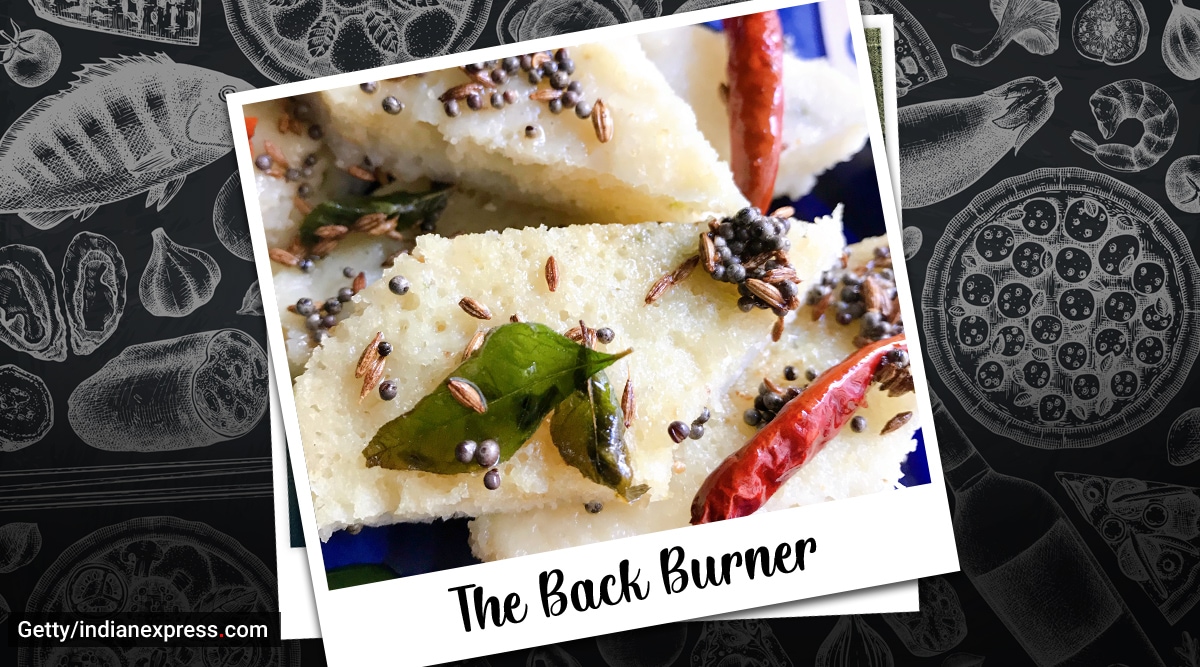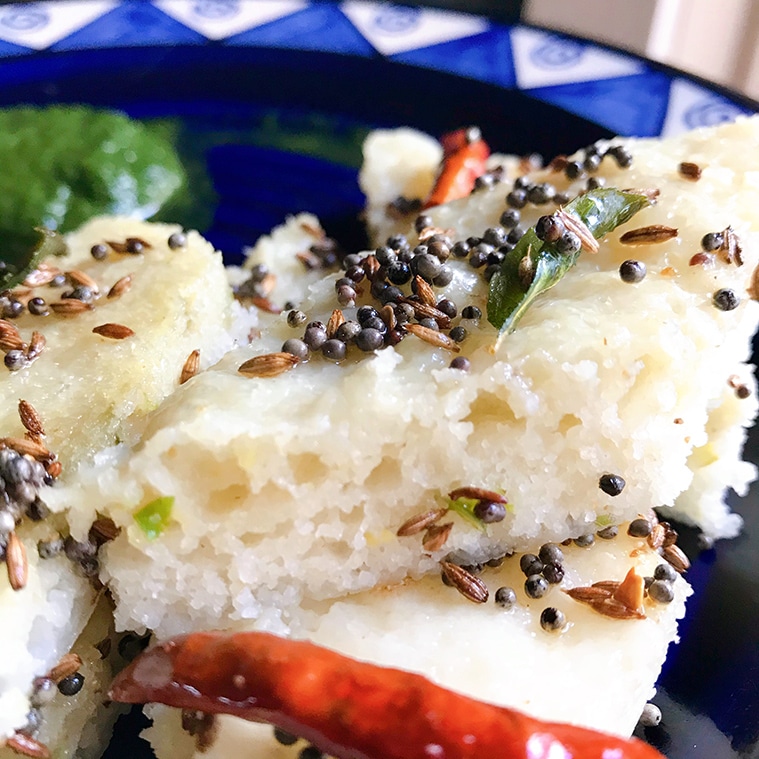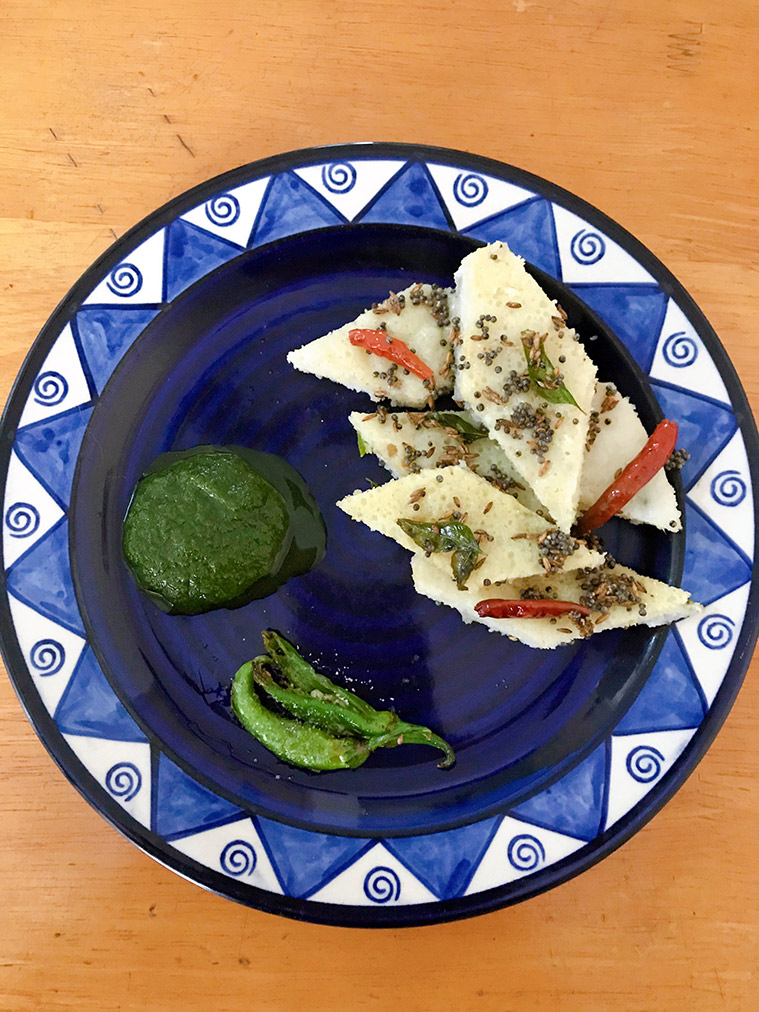 Rava dhokla far less time-consuming to make than regular dhokla which requires rice and dal to be soaked, ground and fermented. (Photo credits: Pooja Pillai; designed by Gargi Singh)
Rava dhokla far less time-consuming to make than regular dhokla which requires rice and dal to be soaked, ground and fermented. (Photo credits: Pooja Pillai; designed by Gargi Singh)I wrote about my travails with rava (sooji or semolina) as an ingredient when I shared my onion rava dosa recipe a few months ago. It’s an ingredient that I’ve continued to use in different ways, mostly with moderate success. One dish that turned out really well was the instant rava dhokla. From start to finish, it took 45 minutes to make, so it’s not exactly quick, but it definitely involves a lot less prep than regular dhokla, which requires rice and dal to be soaked, ground and fermented.
Before we proceed, I’d like to clear up some confusion about terminology. In most parts of the country, dhokla and khaman are used interchangeably to refer to the same yellow, spongy food. But they’re two different things.
Khaman: Always made with soaked gram that is ground to a paste or with gram flour (besan). It is very soft and airy, owing to the use of fruit salt or baking soda. The khaman that is available in shops and restaurants is especially soft and is known as nylon khaman. It is usually a little sweet.
ALSO READ | The Back Burner: Quick and easy garlic podi
Dhokla: Always made with soaked chana dal and rice that is then ground to a paste and fermented. Well-cooked dhoklas are soft, too, but not as much as khaman, and they don’t rise as tall either. There is also a white dhokla that is made with urad dal, instead of chana dal. Dhoklas are almost always tangy.
In this instant rava dhokla recipe, of course, the tang doesn’t come from fermentation. I’ve used citric acid, instead. To make it rise, I’ve used fruit salt.
 Rava dhokla batter isn’t fermented, so to make it rise, one can use either fruit salt or baking soda. (Photo credits: Pooja Pillai)
Rava dhokla batter isn’t fermented, so to make it rise, one can use either fruit salt or baking soda. (Photo credits: Pooja Pillai)
Ingredients:
Rava (sooji) – 1 cup
Water – 1 & ½ cup
Green chillies – 1-2
Ginger – 1 inch piece
Citric acid powder – ½ tsp
Fruit salt (unflavoured) – 1 tsp
Oil, for greasing
Salt, to taste
For tempering:
Any neutral oil – 1 tbsp
Mustard seeds – 1 tsp
Cumin seeds – 1 tsp
Curry leaves – 1 sprig
Dried red chillies – 2-3
Asafoetida – ½ tsp
Method:
* Grind the green chillies and ginger into a paste in a mortar and pestle. You can also grate or chop them fine.
* Add the ginger-green chilli paste to the rava, along with citric acid powder, salt and water. The batter should be about as thick as idli batter. If required, you can add more water, but do so gradually to ensure you don’t loosen the batter too much.
* Allow the batter to rest for 20 minutes.
* Grease the steaming dish you intend to use and set up the steamer with water. You need to keep these ready, because the next step requires you to be very quick.
* After 20 minutes, the batter should be ready. Add the fruit salt, give the batter a quick stir to incorporate it fully (but don’t stir too much) and pour immediately into the greased steaming dish, and spread it out evenly.
* Steam for 20 minutes. Start with a high flame and when you hear the water bubbling inside, reduce the flame to low.
* To check if the dhokla is done, insert a toothpick. If it comes out clean, it’s ready.
 Rava dhokla, served with sweet and sour coriander chutney and fried green chillies. (Photo credits: Pooja Pillai)
Rava dhokla, served with sweet and sour coriander chutney and fried green chillies. (Photo credits: Pooja Pillai)
* Once the dhokla has cooled, demould it and cut into squares or diamonds.
* Temper with mustard seeds, cumin seeds, curry leaves, dried red chillies and asafoetida.
* Serve as is or with chutney of choice. Many like to eat dhoklas with ketchup and a few (brave) souls drizzle it with raw peanut oil.
Notes:
If you don’t want to use citric acid, you can use 1 tsp lime juice to give the dhokla its tang. You can also use sour curd; in this case, you can use 1 cup water and ½ cup curd.
Fruit salt can be substituted with baking soda.
[The Back Burner is a weekly blog that will talk about all things food (with recipes, of course)]